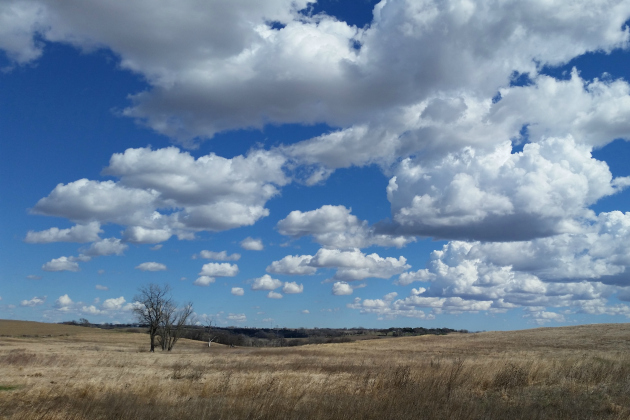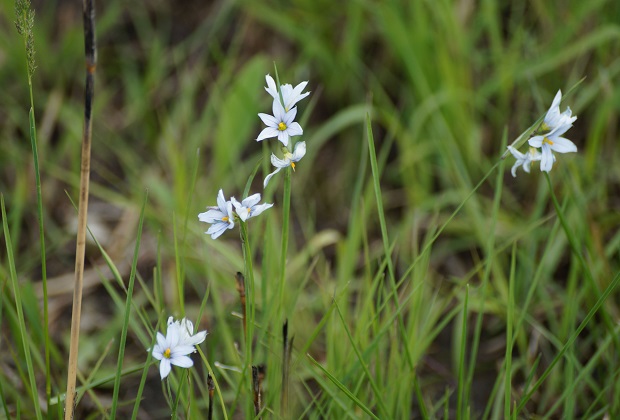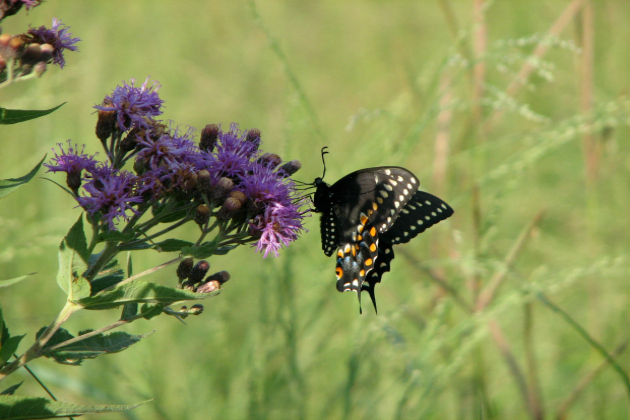Research is Central to the Glacier Creek Preserve Mission

Research at Glacier Creek Preserve: Research is central to the department's vision for Glacier Creek Preserve. Present and past research provides information that furthers our understanding of basic and applied ecosystem processes with a present focus on ecological, geological, and hydrological processes of prairies and prairie restorations. In addition to being a site for short-term study, Glacier Creek Preserve offers two unique opportunities for research, one making available the opportunity for the establishment of long-term studies on prairie restoration and the other having available a unique, replicated suite of burn and mow treatments established in 1978.
Glacier Creek Preserve is supported by an operating budget from the Department of Biology and the College of Arts and Sciences. Except for funded grants that allow Facilities and Administrative (F&A) costs, fees are not charged for use of the preserve for research. If you are including use of the Preserve in a grant proposal, we encourage you to consider including use-fees as they are important to supporting maintenance of all facilities, infrastructure, and services provided by the Preserve. The current fee structure may be requested from the Preserves Director.
Highlights of Past or Present Research:
- Effects of long-term burning or mowing of restored tallgrass prairie on plants, animals, micro-biota (e.g. soil bacteria and fungi), and soil characteristics (e.g. soil respiration, infiltration).
- Distribution and habitat preferences of small mammals, reptiles, and amphibians.
- Prairie restoration with sod and seed.
- Effects of land use change on critical zone processes in the soil.
See Publications and Theses for a list of research projects conducted at Glacier Creek Preserve.
Watch the 2021 Research Conversations at Glacier Creek Preserve event below.
More Detail on Past, Present, and Future Research:
Flora

Studies on the vegetation of Glacier Creek Preserve are highlighted by the long-term nature of both ongoing research and the potential for new long-term research. Highlights of present and potential future research include the following:
Long-Term Prairie Restoration Dynamics: Established in 1970, the 140-acre Allwine Prairie Tract of Glacier Creek Preserve represents decades of post-restoration plant and soil development. Preserve-wide plant community surveys of the Allwine Prairie Tract conducted in 1979, 1993, and 2009 provide a long-term quantitative data set on changes occurring during this time. Future surveys can extend this data set adding further to what we might know about long-term plant dynamics following restoration.
Long-Term Effects of Burning and Mowing on Prairie: A suite of replicated research plots established within the Allwine Prairie Tract in 1978, are among the longest-running, continuously managed burn and mow plots known in the region. The plots, replicated at a second site south of Mead, Nebraska, include annual and quadrennial spring, summer, and fall burning or mulch-mowing plots with vegetative data collected in the plots across the years. These plots provide a unique setting to expand our understanding of long-term management effects on belowground biota or soil processes.
Long-Term Biomass of Restored Tallgrass Prairie: Above-ground biomass sampling of burned and unburned upland and lowland tallgrass prairie has been conducted annually in the fall since 1994. As an example, a comparison of these data with annual weather data, may provide insight on plant-fire-weather interactions.
Vascular and Non-Vascular Plants of Glacier Creek Preserve: A survey of vascular plants, mosses, and lichens at Glacier Creek Preserve (previously Allwine Prairie Preserve) was initiated in 1970's and continues today. Verified specimens are labeled and maintained in the Glacier Creek Herbarium.
Potential Long-Term Prairie Restoration Practices: The recent addition of 148 ha (365 acres) of mostly cropland to Glacier Creek Preserve provides opportunities for superimposing long-term research on prairie restoration as these new acquisitions are restored over the years.
Habitat Diversity of Glacier Creek Preserve: The recent expansion of the preserve increased habitat diversity available for research by adding a second, small creek (North Creek) as well as slope wetlands, wetlands that developed along mid-slope springs, and a historic wetland. These additional habitats provide many opportunities for new studies at the Preserve.
Vertebrate Fauna

Birds: Quantitative data have been collected on grassland birds as part of thesis projects or faculty research, but the Preserve provides many opportunities to expand, particularly with increased size and habitat diversity. See Publications and Theses for listing of completed research projects.
Mammals: A study of the habitat distribution of small mammals was conducted from 2012-2014 in the newly acquired Papio Tract and Barbi Hayes Overlook. In 2016, a long-term, small mammal survey was initiated in the Allwine Prairie Tract and the Barbi Hayes Overlook to assess composition and to begin to assess long-term changes in small mammals in farmed and prairie habitats.
Herpetofauna: A study was conducted from 2015-2017 on habitat distribution of herpetofauna in the Allwine Prairie Tract. A more detailed study and a long-term monitoring project began in 2018 and utilizes artificial cover objects (plywood and corrugated metal sheets) to attract reptiles for further study. Additionally, a radiotelemetry study on western foxsnakes, Pantherophis ramspotti, began in 2019 and is ongoing. Learn more about this study.
Invertebrate Fauna and Other Biota

Butterflies: Since 1998, twenty weekly Pollard Transect butterfly population censuses have been conducted each year from early June to mid-October by Dr. Ted Burk of Creighton University. In addition, since 2001, data also have been collected on nectar plant visits by butterflies observed during each census. Results to date provide a characterization of the butterfly community of the Allwine Prairie Tract across the seasons, quantify nectar plants use by the butterfly community, and assess the effects of preserve management, which includes prescribed burning.
Other Invertebrates: While butterflies have been and continue to be well studied, the Preserve would benefit from additional work on other above-ground, below-ground, and aquatic invertebrate groups.
Other Biota: The soil bacterial and fungal communities in burned, mowed, and untreated long-term research plots were evaluated in 2014-2015. Preliminary results show noticeable differences among treatments suggesting an area ready for further study, including on other soil biota.
Monitoring the Preserve’s Environment
To assess, over time, environmental characteristics of the Preserve, several parameters are measured regularly including water flow and quality, siltation, weather, and soil temperature and moisture.
Water flow: The rate of water flow of Glacier Creek has been measured variously since the 2000's but, since 2015, has been measured monthly. Based on these data, Glacier Creek maintains a base flow of 260 liter/min (9 ft3 or 69 gallons/min), even during the drought year of 2012. The recent installation of a flow-meter will allow us to continuously assess changes in the rate of flow of Glacier Creek giving a more precise rate of flow, particularly after heavy rain events or rapid snow melt.
Water quality: The recent installation of a sonde will provide continuous data on the water quality characteristics of Glacier Creek. Glacier Creek, with the highest water quality in the region, was recently selected as the Douglas County Reference Stream.
Siltation: To record the rate of silt accumulation from the adjacent farm field to the west, a series of poles were established in the 1990's with changes in silt depth recorded at each pole several times each year.
Weather and Soil: Starting in the fall of 2016, weather data have been collected from two on-preserve stations, one in cropland and the other in the restored prairie. In addition to atmospheric conditions, both weather stations record soil temperature and moisture at depths of 10 cm, 25 cm, 50 cm, and 100 cm. These data are available on request from the Preserves Director. Data from an earlier weather station, also available on request, have been collected since the 1990's, although there are gaps due to various technical issues. In addition to weather station data, a series of seven recording nodes were established along a topographic gradient, from hilltop to north-facing slopes, lowland, and south-facing slopes. Each node records both atmospheric and soil temperature conditions providing data on differences in micro-climate due to aspect (aspect = compass direction that a slope faces).
Management History: Management practices, including locations of invasive species, native sod transplants, and seed scattering locations across the Allwine Prairie Tract have been documented since the original restoration in 1970. Records are maintained in a GIS data base. Availability of these data bases may be determined by contacting the Preserves Director.
Solar Energy Research Test Facility
Glacier Creek Preserve currently houses a solar energy research test facility that is maintained by the Computer and Electronics Engineering Department, College of Engineering, University of Nebraska-Lincoln.
For more information contact Dr. Bing Chen or visit the Passive Solar Research Group.